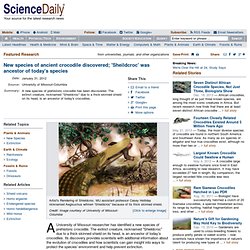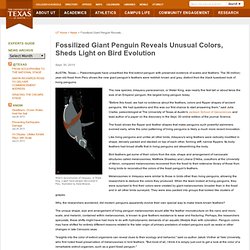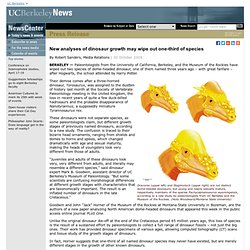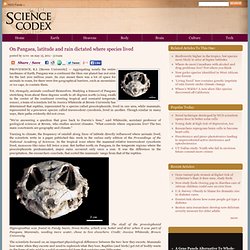

New species of ancient crocodile discovered. A University of Missouri researcher has identified a new species of prehistoric crocodile.

The extinct creature, nicknamed "Shieldcroc" due to a thick-skinned shield on its head, is an ancestor of today's crocodiles. Its discovery provides scientists with additional information about the evolution of crocodiles and how scientists can gain insight into ways to protect the species' environment and help prevent extinction. The discovery was published this week in the journal PLoS ONE (Public Library of Science). "Aegisuchus witmeri or 'Shieldcroc' is the earliest ancestor of our modern crocodiles to be found in Africa," said Casey Holliday, co-researcher and assistant professor of anatomy in the MU School of Medicine.
"Along with other discoveries, we are finding that crocodile ancestors are far more diverse than scientists previously realized. " Vendian Animals. Strange Science: The Rocky Road to Modern Paleontology and Biology. Introducing the palaeontology of Great Britain. Welcome to The Bone Room Web Site.
Find Dinosaur Pictures - Illustrations of Dinosaurs - Dinosaurios - Dinosaur Art. A Guide to the Orders of Trilobites. 190-million-year-old dinosaur nesting site found - Technology & Science. A Canadian-led team of international researchers has unearthed the 190-million-year-old nesting site of the prosauropod dinosaur Massospondylus — predating previously known nesting grounds by 100 million years — at an excavation site in South Africa.

The finding was published Monday in the Proceedings of the National Academy of Sciences. Strange Science: Dinosaurs and Dragons. Despised in the West and revered in the East, dragons have a long history in human mythology. How did the myth start? No one knows the exact answer, but some myths may have been inspired by living reptiles, and some "dragon" bones probably belonged to animals long extinct — in some cases dinosaurs, in others, fossil mammals. Starting in the early 19th century, scientists began to find a new kind of monster, one that had gone extinct tens of millions of years before the first humans evolved.
Because the first fragments found looked lizard-like, paleontologists assumed they had found giant lizards, but more bones revealed animals like nothing on earth today. Did these terrible lizards ever coexist with people? Most Recent Additions Mar-08-2014 Feb-21-2014 Year: 1853 Scientist: Sir Richard Owen Artist: Benjamin Waterhouse Hawkins Still appears in: Crystal Palace Park, London (photo by Michon Scott) Besides Iguanodon and Megalosaurus, the Crystal Palace Park sculptures included Hylaeosaurus. Fossilized Giant Penguin Reveals Unusual Colors, Sheds Light on Bird Evolution. Sept. 30, 2010 AUSTIN, Texas — Paleontologists have unearthed the first extinct penguin with preserved evidence of scales and feathers.

The 36-million-year-old fossil from Peru shows the new giant penguin's feathers were reddish brown and grey, distinct from the black tuxedoed look of living penguins. Artist's reconstruction of Inkayacu, or Water King, a giant fossil penguin discovered in Peru. Illustration by Katie Browne. 10.30.2009 - New analyses of dinosaur growth may wipe out one-third of species. By Robert Sanders, Media Relations | 30 October 2009 BERKELEY — Paleontologists from the University of California, Berkeley, and the Museum of the Rockies have wiped out two species of dome-headed dinosaur, one of them named three years ago – with great fanfare – after Hogwarts, the school attended by Harry Potter.

Dracorex (upper left) and Stygimoloch (upper right) are not distinct dome-headed dinosaurs, but young and nearly sexually mature, respectively, members of the species Pachycephalosaurus wyomingensis, according to a new study by paleontologists from UC Berkeley and the Museum of the Rockies. (Holly Woodward/Montana State University) 5 "Oddball" Crocs Discovered, Including Dinosaur-Eater. November 19, 2009 ON TV When Crocs Ate Dinosaurs airs Saturday, November 21, at 9 p.m.

ET/PT on the National Geographic Channel. Preview Crocs >> A "saber-toothed cat in armor" and a pancake-shaped predator are among the strange crocodile cousins whose bones have been found beneath the windswept dunes of the Sahara, archaeologists say. Oldest Human Fossils Found. National Fossil Day - Home. 650 Million Years in 1 Min. and 20 Sec. Video.
Geologic Time: Graphical Representation of Geologic Time. 06.06.2007 - Agonized pose tells of dinosaur death throes. UC Berkeley Press Release.

On Pangaea, latitude and rain dictated where species lived. PROVIDENCE, R.I.

[Brown University] — Aggregating nearly the entire landmass of Earth, Pangaea was a continent the likes our planet has not seen for the last 200 million years. Its size meant there was a lot of space for animals to roam, for there were few geographical barriers, such as mountains or ice caps, to contain them. Yet, strangely, animals confined themselves. Studying a transect of Pangaea stretching from about three degrees south to 26 degrees north (a long swath in the center of the continent covering tropical and semiarid temperate zones), a team of scientists led by Jessica Whiteside at Brown University has determined that reptiles, represented by a species called procolophonids, lived in one area, while mammals, represented by a precursor species called traversodont cynodonts, lived in another.
Though similar in many ways, their paths evidently did not cross. The scientists focused on an important physiological difference between the two: how they excrete.